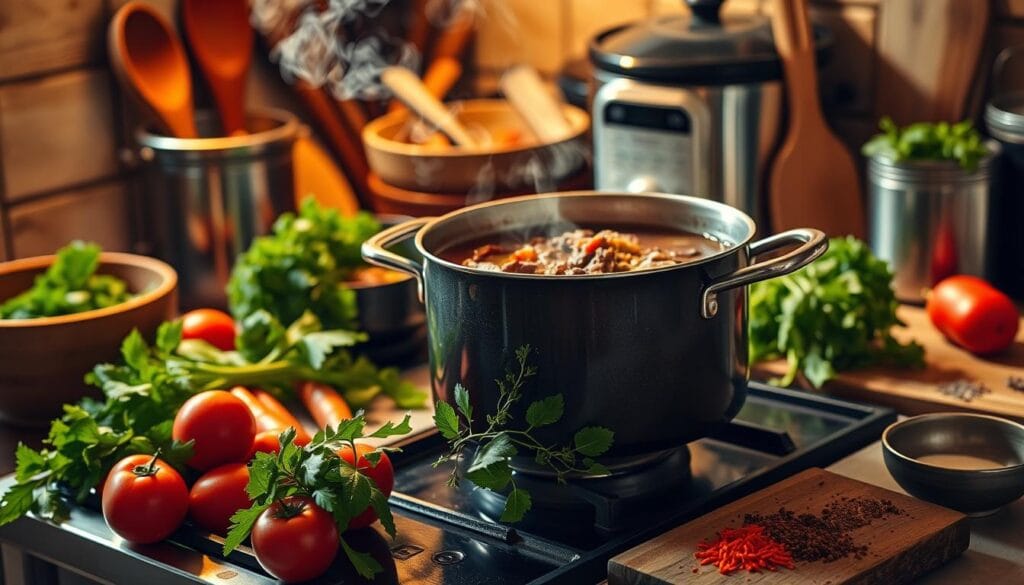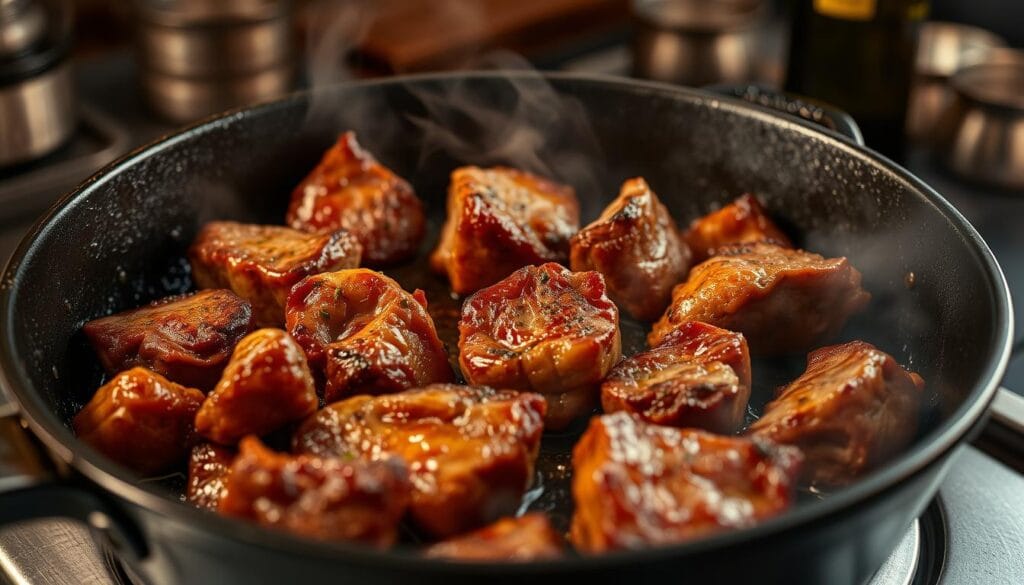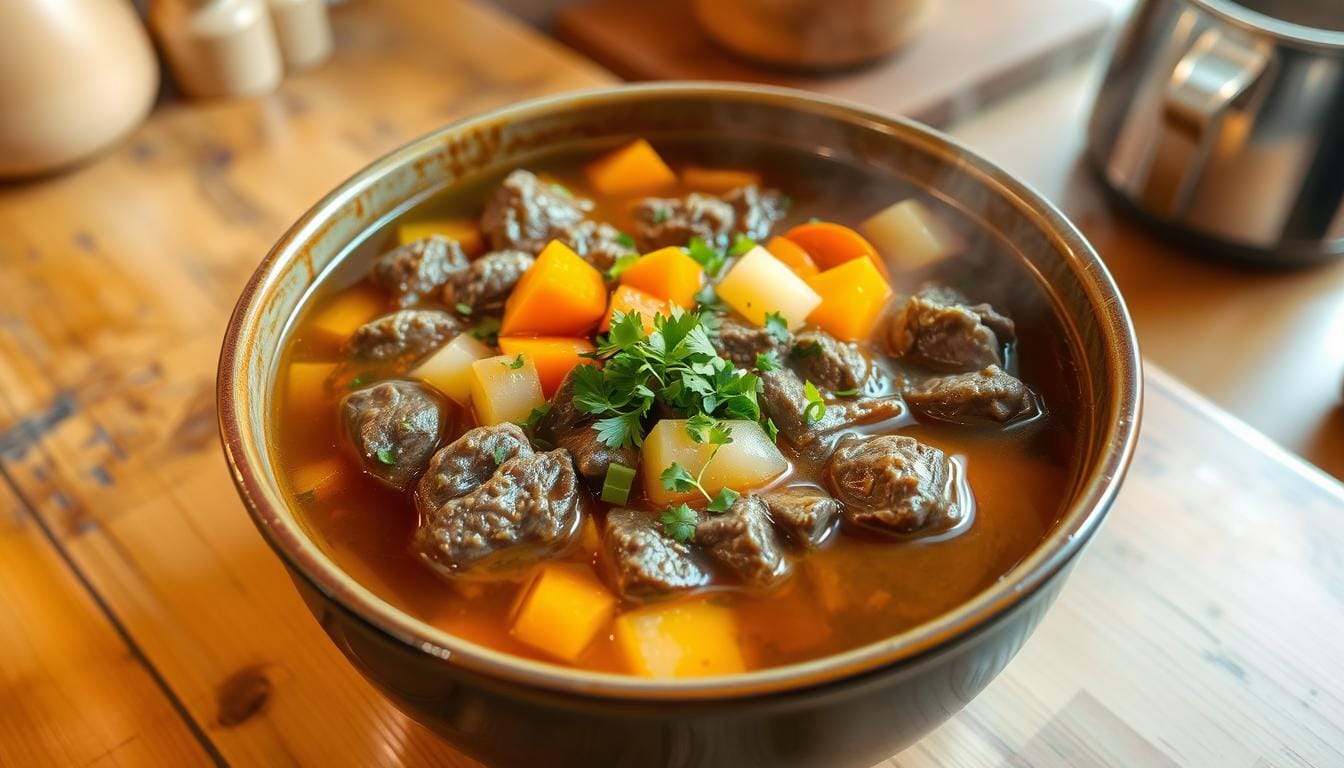How do you add richness to beef soup? As autumn’s chill arrives, nothing warms the soul like a hot bowl of beef soup. I remember my grandmother’s beef soup filling our house with its scent. The broth, beef, and vegetables made it a satisfying meal.
If you want to make your beef soup rich and flavorful, you’re in the right place. This guide will show you how to transform a simple soup into a masterpiece by teaching you techniques like choosing the right beef and deglazing to bring out the flavor.
This guide is for both seasoned cooks and beginners. It will help you craft a beef soup that everyone will love. Let’s dive in and discover how to make your beef soup irresistibly rich and full of depth.
Understanding the Basics of Beef Soup Base
Creating a rich and flavorful beef soup starts with the soup base. The beef stock or broth you pick, along with the right beef cut and base vegetables, are key. They determine the soup’s depth and complexity.
Choosing the Right Cut of Beef
For the best results, choose a boneless beef chuck roast. It becomes tender and adds a rich flavor to the soup. It’s wise to buy about 30% more beef than the recipe calls for, after trimming.
Quality of Stock and Broth
Start with a high-quality, low-sodium beef stock or broth. Avoid using beef base products like bouillon cubes or paste. They often have sodium, preservatives, and lower-quality ingredients. Mixing beef and chicken broth, or adding a splash of dry red or white wine, can enhance the flavor.
Essential Base Vegetables
The classic mirepoix – onions, carrots, and celery – is the aromatic base of a rich beef soup. These vegetables add sweetness, depth, and complexity. Make sure to sauté them well to bring out their full flavor.
By focusing on these basic elements, you’ll make a beef soup full of robust, delicious flavor.
The Science Behind Creating Rich Flavors
How do you add richness to beef soup? The rich flavors of beef soup come from chemical reactions during cooking. Knowing these science basics can make your homemade soup taste better.
The Maillard reaction is key for umami taste. It happens when beef browns, mixing amino acids and sugars. This creates new flavors. Searing the meat well is crucial for that beefy taste.
Caramelizing onions is also important. As onions cook, their sugars turn into a sweet, nutty flavor. This adds depth to the soup.
Adding tomato paste and Parmesan rinds boosts umami. These ingredients have glutamates that make the soup taste richer and more satisfying.
Understanding these science tips is essential for learning how to add richness to beef soup and create a standout dish. It will wow your family and friends.
“A well-crafted stock can enhance the flavor and complexity of various dishes, such as soups, stews, sauces, risottos, and braises.”
| Flavor Component | Science Behind It | Impact on Beef Soup |
|---|---|---|
| Umami | Glutamates in ingredients like tomato paste and Parmesan | Enhances the savory, satisfying taste |
| Caramelization | Breakdown and recombination of sugars in onions | Adds depth, sweetness, and nutty notes |
| Maillard Reaction | Interaction of amino acids and reducing sugars during browning | Develops complex, beefy, and aromatic flavors |
How Do You Add Beef Soup?
To make your beef soup truly satisfying, focus on adding depth of flavor. Using tomato paste is a key technique. It brings a savory, umami-rich taste that blends well with the beef broth, making the soup richer.
Using Tomato Paste for Umami
Add a couple of tablespoons of tomato paste towards the end of cooking. It adds a strong tomato flavor and thickens the soup, making it velvety. The tomato paste’s sweetness and acidity balance the other flavors, creating a well-rounded taste.
Wine Deglazing Technique
Using the wine deglazing technique can also enhance your beef soup. After browning the beef, pour in a bit of red wine or sherry. This step adds a subtle, complex wine flavor that pairs well with the beef.
Incorporating Herbs and Spices
Aromatic herbs and spices are crucial for a rich flavor in beef soup. Try using fresh thyme, rosemary, and bay leaves, or an Italian seasoning blend for an earthy taste. Let these flavors mix during the long simmering process for a sublime soup.
By using tomato paste for umami, deglazing with wine, and adding herbs and spices wisely, you can make your beef soup richer and more complex. These techniques will impress your family and friends, making them want more of this comforting dish.
The Role of Slow Cooking in Flavor Development
“Slow cooking is the secret to unlocking the true depth of flavor in beef soup. The long, gentle simmering allows the ingredients to meld together in perfect harmony, resulting in a dish that’s both nourishing and deeply satisfying.”
If you want a truly rich beef soup, try slow cooking. With patience and the right techniques, you’ll get a tender beef broth full of savory goodness.

Essential Ingredients for Deep Flavor
Making a flavorful beef soup starts with picking the right ingredients. At the heart is the aromatic vegetables that add depth and complexity.
Aromatics and Their Impact
The base of a great beef soup is garlic, onions, and celery. These ingredients create a savory and fragrant flavor base. Garlic and onions bring sweetness and umami. Celery adds a subtle earthiness that balances the flavors.
Best Herb Combinations
Herbs are key in enhancing beef soup flavors. The best mix is rosemary, thyme, and bay leaf. These herbs add a warm, herbaceous aroma that complements the beef. Adding a bit of parsley brings a fresh, bright note.
Vegetable Selection Guide
- Carrots add sweetness and color to the soup.
- Potatoes, especially red-skinned, make the soup creamy and comforting without peeling.
- Frozen mixed vegetables add volume, nutrients, and convenience.
By choosing and mixing these ingredients, you can make a beef soup that’s unforgettable. It warms the soul and delights the senses.
| Nutrient | Per Serving |
|---|---|
| Calories | 344kcal |
| Carbohydrates | 31g |
| Protein | 28g |
| Fat | 14g |
| Saturated Fat | 6g |
| Cholesterol | 78mg |
| Sodium | 714mg |
| Potassium | 1420mg |
| Fiber | 7g |
| Sugar | 9g |
| Vitamin A | 8029IU |
| Vitamin C | 43mg |
| Calcium | 139mg |
| Iron | 8mg |
“The secret to a truly delectable beef soup lies in the harmonious blend of aromatic vegetables, herbs, and spices.”
Professional Techniques for Browning Meat
How do you add richness to beef soup? One essential technique is properly browning the meat. The Maillard reaction creates a flavorful crust on the beef, significantly boosting the flavor development in your soup.
Begin by cutting 3 pounds of boneless beef chuck into 1½-inch pieces. Brown the meat in 3 batches to avoid overcrowding. Use a heavy-bottomed pot or Dutch oven for even searing.
Sear the beef cubes in a single layer, allowing them to develop a rich, caramelized crust.
Once the first batch is browned, remove the meat from the pan and repeat the process with the remaining portions.
Incorporating the browned beef back into the soup will infuse the broth with deep, savory flavors.
Browning the meat is a crucial step in answering the question, “How do you add richness to beef soup?” This effort ensures a soup that is richer, more delicious, and packed with depth.
| Ingredient | Quantity |
|---|---|
| Boneless Beef Chuck | 3 pounds |
| Batches for Browning | 3 |
| Browning Time per Batch | 5 minutes |
| Dry Red Wine | 2 cups |
| Beef Broth | 2 cups |
| Braising Time | 2 hours |

“The secret to a truly exceptional beef soup lies in the searing of the meat. It’s the key to unlocking the hidden depths of flavor.”
Thickening Methods for Rich Consistency
To make your beef soup thicker and more indulgent, try a few techniques. One way is to make a roux. This is a mix of butter and flour, equal parts. By simmering it in the broth, you thicken the soup and get a smooth texture.
Another method is the cornstarch slurry. Mix a tablespoon of cornstarch with cold water, then add it slowly to the soup. This keeps the flavor the same but thickens it. Or, you can just let the soup simmer longer to reduce the liquid and make it thicker.
Choose the method that works best for you, keeping in mind how thick you want the soup. By trying these techniques, you can make your beef soup richer and more comforting.

